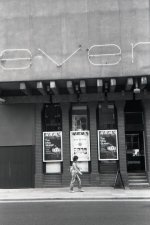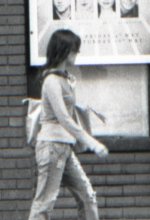oscroft
Veteran
I've just tried my first few rolls of Delta 400 in HC-110. They were exposed at 400ASA and I gave them 7:30 at 20 deg C using dilution B (I got the dev time from The Massive Dev Chart). The neg density looks quite nice (very similar to the density I get with Rodinal - I've done that quite a bit to get pronounced grain structure, but now I'm looking for a bit less obvious grain).
But my problem is that the contrast is very high, with blown highlights and impenetrable shadows - I've attached three samples from one shot to show what I mean. I think the exposure is about right for the dev time - shots that are mostly mid-tones look just about right.
Any ideas what I could do to get lower contrast? I could reduce the dev time a little, but I don't really want low density negs (and I guess I'd get even less in the shadows) - I mainly scan, for which lower density negs would be good, but I still want to be able to do proper wet prints too (and I do get good scans from negs done in Rodinal with similar density - they just seem to have lower contrast). Is there a combination of film speed/dev time tweaks that might do what I want and bring the contrast down a bit?
I guess it's possible that I might just have chosen a poor film/developer combination, but right now my fridge is full of Delta 400 and Delta 100, my bottle of HC-100 is nearly full, and I'll be heading off in just a few weeks to do some serious shooting and so I don't really have any time for ordering and trying different films and developers (though I have a roll of Delta 100 that I'm going to try in Rodinal later today).
So, any advice would be welcomed.
Best regards,
But my problem is that the contrast is very high, with blown highlights and impenetrable shadows - I've attached three samples from one shot to show what I mean. I think the exposure is about right for the dev time - shots that are mostly mid-tones look just about right.
Any ideas what I could do to get lower contrast? I could reduce the dev time a little, but I don't really want low density negs (and I guess I'd get even less in the shadows) - I mainly scan, for which lower density negs would be good, but I still want to be able to do proper wet prints too (and I do get good scans from negs done in Rodinal with similar density - they just seem to have lower contrast). Is there a combination of film speed/dev time tweaks that might do what I want and bring the contrast down a bit?
I guess it's possible that I might just have chosen a poor film/developer combination, but right now my fridge is full of Delta 400 and Delta 100, my bottle of HC-100 is nearly full, and I'll be heading off in just a few weeks to do some serious shooting and so I don't really have any time for ordering and trying different films and developers (though I have a roll of Delta 100 that I'm going to try in Rodinal later today).
So, any advice would be welcomed.
Best regards,
Attachments
John Bragg
Well-known
Hi, Alan.
I have no experience of Delta 400, but with Neopan 400 in HC-110 I have gotten good results by rating at EI 200 to open up the shadows and developing in Dilution H (half the strenghth of B). This further dilution allows great flexibility in controlling highlight contrast by allowing some compensation, the degree of which is varied by the ammount of agitation given. HC-110 used in this way gives good sharpness and fine regular grain whilst taming highlights. I give an initial 30 secs followed by 2 gentle inversions at the start of each subsequent minute. (9 mins at 20c for Neopan and Tri-X). If you start at 2X time for Dil B and Knock off 20% for EI change you should be somewhere near.....
Regards John.
I have no experience of Delta 400, but with Neopan 400 in HC-110 I have gotten good results by rating at EI 200 to open up the shadows and developing in Dilution H (half the strenghth of B). This further dilution allows great flexibility in controlling highlight contrast by allowing some compensation, the degree of which is varied by the ammount of agitation given. HC-110 used in this way gives good sharpness and fine regular grain whilst taming highlights. I give an initial 30 secs followed by 2 gentle inversions at the start of each subsequent minute. (9 mins at 20c for Neopan and Tri-X). If you start at 2X time for Dil B and Knock off 20% for EI change you should be somewhere near.....
Regards John.
oscroft
Veteran
Thanks John, that's very interesting - I'll give it a go
John Bragg
Well-known
Let me know how things go. I guesstimate a time of 12 mins in dilution H at EI 200. I have one roll of Delta 400, courtesy of Black and White magazine and I may try it like this when I get a chance.
Regards, John.
Regards, John.
mr_phillip
Well-known
oscroft said:I guess it's possible that I might just have chosen a poor film/developer combination, but right now my fridge is full of Delta 400 and Delta 100, my bottle of HC-100 is nearly full, and I'll be heading off in just a few weeks to do some serious shooting and so I don't really have any time for ordering and trying different films and developers (though I have a roll of Delta 100 that I'm going to try in Rodinal later today).
I'm afraid my experience of Delta 400 in HC-110 suggests that this is indeed just a bad combo. I got unpleasant grain and blown highlights too – it's the ony combo I've just never managed to get something I like from (I've never tried Delta 100 in HC-110 so I can't comment on that).
The best results I've had from Delta 400 came from using DD-X or XTOL. Generally I tend to prefer HP5+ anyway (which is wonderful in HC-110 BTW). Delta 100 I always use either Rodinal or Neofin Blue - both of which give great (if rather different) results. Personally I'd be quite tempted to try rating the Delta 400 at 200ASA and souping it in Rodinal instead.
Good luck.
FrankS
Registered User
Excessive contrast with HC-110 use comes from excessive agitation. I've just switched to using HC-110 and that is what I've learned so far, mainly from advice from more experienced users. I'm using a higher dilution, 1:100 and extended developing time (3x what's recommended for dilution B), constant agitation for 1st minute, then 10sec every 3 minutes. An interesting bit of modification is to agitate every 3 min if pictures were taken in flat lighting, every 4 min in normal or mixed lighting, and every 5 min if the lighting was contrasty.
Agitation affects contrast.
For some reason, 120 film requires additional development time compared to 35mm film.
Agitation affects contrast.
For some reason, 120 film requires additional development time compared to 35mm film.
eric
[was]: emaquiling
oscroft said:I've just tried my first few rolls of Delta 400 in HC-110. est regards,
My favorite combo in sunny Socal weather is Delta 400 @ 320 processed in PMK. It creates a very similar grain structure as tri-x in d76 but with PMK, I can really control the highlights in printing. So much easier to print those wide range of highlights and shadows in this sunny weather.
HTH!
oscroft
Veteran
Thanks for the suggestions. I've just done a roll of Delta 100 in Rodinal for the first time - I'll scan it later and see what it looks like.
The next thing I'll try is less agitation with Delta 400/HC-110 (and more dilution sounds like the way to go, with exposure at 320 or maybe 200 ASA) - I did my first ones with 30 secs continuous agitation, then 10 secs every minute (this was 7:30 at dilution B).
HP5+ in HC-110 is something I'll certainly try a bit later - I used HP5 a lot in the past and liked it then.
And when my trial bottle of HC-110 runs out (I only got the small bottle for a first try, not the big bottle of super-concentrate, so it won't last too long) I'll try some of the other developer suggestions. I do like using liquid concentrates though - they're so convenient.
Thanks again,
The next thing I'll try is less agitation with Delta 400/HC-110 (and more dilution sounds like the way to go, with exposure at 320 or maybe 200 ASA) - I did my first ones with 30 secs continuous agitation, then 10 secs every minute (this was 7:30 at dilution B).
HP5+ in HC-110 is something I'll certainly try a bit later - I used HP5 a lot in the past and liked it then.
And when my trial bottle of HC-110 runs out (I only got the small bottle for a first try, not the big bottle of super-concentrate, so it won't last too long) I'll try some of the other developer suggestions. I do like using liquid concentrates though - they're so convenient.
Thanks again,
oscroft
Veteran
Effects of agitation?
Effects of agitation?
Just a few questions about agitation, if don't mind me picking a few brains.
If I agitate less, presumably that's going to allow the developer to become more exhausted in the more active areas and so hold back the highlights a bit? If that's so, would that produce a less dense negative (in addition to a less contrasty one)? And if it does, should I compensate by increasing the development time a bit to improve the shadows? (Obviously I'll compensate for any changes in dev time and film speed too).
The reason I'd like to persevere with this is that I've scanned some more of my Delta 400 done in HC-110 and, though I'm still seeing the same highlight/shadow problems (they're from the same dev session), I do quite like the mid tones that I'm getting. I've attached another example (which has had a little bit of unsharp mask applied after scanning) to show what I mean - I know it's hard to see much in a small jpg sample, but it might convey something of what I'm talking about.
Effects of agitation?
Just a few questions about agitation, if don't mind me picking a few brains.
If I agitate less, presumably that's going to allow the developer to become more exhausted in the more active areas and so hold back the highlights a bit? If that's so, would that produce a less dense negative (in addition to a less contrasty one)? And if it does, should I compensate by increasing the development time a bit to improve the shadows? (Obviously I'll compensate for any changes in dev time and film speed too).
The reason I'd like to persevere with this is that I've scanned some more of my Delta 400 done in HC-110 and, though I'm still seeing the same highlight/shadow problems (they're from the same dev session), I do quite like the mid tones that I'm getting. I've attached another example (which has had a little bit of unsharp mask applied after scanning) to show what I mean - I know it's hard to see much in a small jpg sample, but it might convey something of what I'm talking about.
Attachments
charjohncarter
Veteran
I agree with FrankS. Moderate your agitation, in both frequency and aggressiveness. But you will have to adjust your developing time, possibly. This guy discusses agitation and HC-110: http://www.mironchuk.com/hc-110.html
oscroft
Veteran
That's brilliant, thanks very much.I agree with FrankS. Moderate your agitation, in both frequency and aggressiveness. But you will have to adjust your developing time, possibly. This guy discusses agitation and HC-110: http://www.mironchuk.com/hc-110.html
John Bragg
Well-known
oscroft said:Just a few questions about agitation, if don't mind me picking a few brains.
If I agitate less, presumably that's going to allow the developer to become more exhausted in the more active areas and so hold back the highlights a bit? If that's so, would that produce a less dense negative (in addition to a less contrasty one)? And if it does, should I compensate by increasing the development time a bit to improve the shadows? (Obviously I'll compensate for any changes in dev time and film speed too).
The reason I'd like to persevere with this is that I've scanned some more of my Delta 400 done in HC-110 and, though I'm still seeing the same highlight/shadow problems (they're from the same dev session), I do quite like the mid tones that I'm getting. I've attached another example (which has had a little bit of unsharp mask applied after scanning) to show what I mean - I know it's hard to see much in a small jpg sample, but it might convey something of what I'm talking about.
To clarify.
Shadow density is governed principally by exposure, whilst highlights are more a function of development. The aim of compensating development therefore, is to allow (proportionally), more development in the shadows and mid tones and at the same time the dilute developer in contact with the highlight areas exhausts more quickly. Thus, you can use agitation to fine tune contrast. The negative produced in this way will be less dense in the highlights, but overall there will be more useful density in the important shadow details,(especially when coupled with adequate exposure), tranlating to a print or scan with the right contrast from the start needing less manipulation to get the right look on paper or the screen. _
oscroft
Veteran
Thanks John, that makes a lot of sense - HC-110 is the first developer I've tried that has given me such contrasty highlights. I'll have a go as you suggest at the weekend and see how it goes.Shadow density is governed principally by exposure, whilst highlights are more a function of development. The aim of compensating development therefore, is to allow (proportionally), more development in the shadows and mid tones and at the same time the dilute developer in contact with the highlight areas exhausts more quickly. Thus, you can use agitation to fine tune contrast. The negative produced in this way will be less dense in the highlights, but overall there will be more useful density in the important shadow details,(especially when coupled with adequate exposure), tranlating to a print or scan with the right contrast from the start needing less manipulation to get the right look on paper or the screen
John Bragg
Well-known
Best of luck with it Alan. I am sure you will get more joy with Dilution H. It works alike a charm for me with Neopan 400, which has an ill deserved reputation for being too contrasty. (Most folks just shake the tank too much).
Regards, John.
Regards, John.
FrankS
Registered User
I'm still a novice with this developer (about 5 rolls developed so far) but I'm liking the possibility of contrast control with it. This is the reason I do B+W and don't bother with colour - control. With colour it has to be done just so. After a few months of using Diafine, I just dumped it. I didn't like the lack of control.
John Bragg
Well-known
Thats it in a nut shell Frank ! Iused to do everything as per the box instructions, but my work seriously lacked something. The major benefit of developing your own is the potential for such fine tuning, and there is much to be gained once you get your personal film EI and dev times dialed in.
Regards, john.
Regards, john.
x-ray
Veteran
HC110 / Ilford HC has been my genera purpose developer since 1975. I was one of the trade trial testers for ilford for the Delta 100 and 400 prior to its release in the market. I shot hundreds of rolls of 35mm of both emulsions and revised formulations of the two films and evaluated results and reported my findings to Ilford. I found HC110 / HC and both films to be an exceptional combo. I liked the results so much these are my two standard films and my standard developer.
I will confirm that it's easy to buile contrast with these films and developers but I also find it extremely easy to fine tune by changing dilution / agitiation and time. I now use 1:47 for contrasty secnes with very moderate agitiation and 1:32 with moderate agitiation for normal to flat scenes. For extremely contrasty scenes I tate the 400 at 100 and pull 2 stops in 1:47.
Just spend tome time with it and learn to use it. Experiment and keep notes. You'll hit it and love the results.
I will confirm that it's easy to buile contrast with these films and developers but I also find it extremely easy to fine tune by changing dilution / agitiation and time. I now use 1:47 for contrasty secnes with very moderate agitiation and 1:32 with moderate agitiation for normal to flat scenes. For extremely contrasty scenes I tate the 400 at 100 and pull 2 stops in 1:47.
Just spend tome time with it and learn to use it. Experiment and keep notes. You'll hit it and love the results.
oscroft
Veteran
Excellent, thanks. From what I've been reading (here and other places) HC-110 does sound like a very versatile developer. In fact, I was out walking today and the weather was pretty dull and grey - the kind of light where anything that I shot on Delta and developed in Rodinal would have come out pretty flat. And it had me thinking "That extra highlight contrast I got with HC-110 would be just the job for this". I do hope I get some bright weather this weekend so I can try pulling Delta 400 and developing in dilution H.I will confirm that it's easy to buile contrast with these films and developers but I also find it extremely easy to fine tune by changing dilution / agitiation and time. I now use 1:47 for contrasty secnes with very moderate agitiation and 1:32 with moderate agitiation for normal to flat scenes. For extremely contrasty scenes I tate the 400 at 100 and pull 2 stops in 1:47.
Just spend tome time with it and learn to use it. Experiment and keep notes. You'll hit it and love the results.
John Bragg
Well-known
Hi, Alan.
I have found that even in flat lighting conditions, negatives produced with this developer have enough bite to print successfully on a harder grade of paper. I aim my development for printing on G 2.5 , but even in "flat" lighting, there is no problem printing on G 3. Hence I standardise my dev time to account for high contrast subjects, and control lower contrast subjects with paper grade, ie filtration on the VC head of my Kaiser enlarger.
Regards, John.
I have found that even in flat lighting conditions, negatives produced with this developer have enough bite to print successfully on a harder grade of paper. I aim my development for printing on G 2.5 , but even in "flat" lighting, there is no problem printing on G 3. Hence I standardise my dev time to account for high contrast subjects, and control lower contrast subjects with paper grade, ie filtration on the VC head of my Kaiser enlarger.
Regards, John.
oscroft
Veteran
That sounds pretty impressive. Until I get my wet darkroom set up, it sounds like I'll be easily able to do the same and adjust for lower contrast with post processing.I have found that even in flat lighting conditions, negatives produced with this developer have enough bite to print successfully on a harder grade of paper. I aim my development for printing on G 2.5 , but even in "flat" lighting, there is no problem printing on G 3. Hence I standardise my dev time to account for high contrast subjects, and control lower contrast subjects with paper grade, ie filtration on the VC head of my Kaiser enlarger
Cheers,
Alan
Share:
-
This site uses cookies to help personalise content, tailor your experience and to keep you logged in if you register.
By continuing to use this site, you are consenting to our use of cookies.




